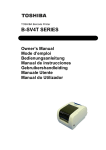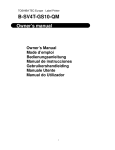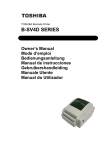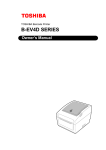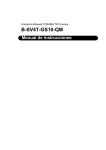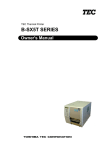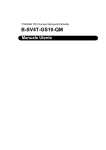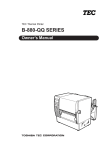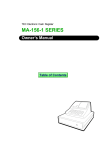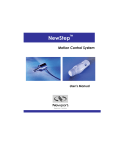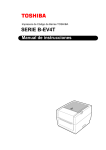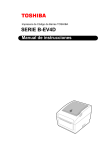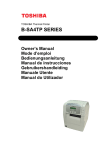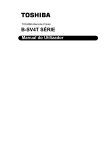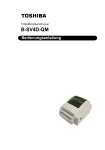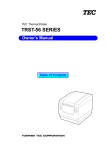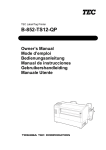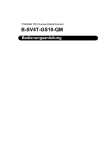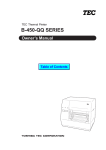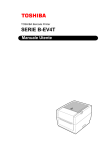Download B-SV4D-QM
Transcript
TEC Label Printer
B-SV4D-QM
Owner’s Manual
CE Compliance (for EU only)
This product complies with the requirements of EMC and Low Voltage Directives including their
amendments.
VORSICHT:
• Schallemission: unter 70dB (A) nach DIN 45635 (oder ISO 7779)
• Die für das Gerät Vorgesehene Steckdose muß in der Nähe des Gerätes und leicht zugänglich sein.
Centronics is a registered trademark of Centronics Data Computer Corp.
Microsoft is a registered trademark of Microsoft Corporation.
Windows is a trademark of Microsoft Corporation.
This equipment has been tested and found to comply with the limits for a Class B digital device,
pursuant to Part 15 of the FCC Rules. These limits are designed to provide reasonable protection
against harmful interference in a residential installation. This equipment generates, uses, and can
radiate radio frequency energy and, if not installed and used in accordance with the instructions, may
cause harmful interference to radio communications. However, there is no guarantee that
interference will not occur in a particular installation. If this equipment does cause harmful
interference to radio or television reception, which can be determined by turning the equipment off
and on, the user is encouraged to try to correct the interference by one or more of the following
measures:
- Reorient or relocate the receiving antenna.
- Increase the separation between the equipment and receiver.
- Connect the equipment into an outlet on a circuit different from that to which the receiver is
connected.
- Consult the dealer or an experienced radio/TV technician for help.
(for USA only)
Changes or modifications not expressly approved by manufacturer for compliance could void the
user’s authority to operate the equipment.
“This Class B digital apparatus meets all requirements of the Canadian Interference-Causing
Equipment Regulations.”
“Cet appareil numérique de la classe B respecte toutes les exigences du Règlement sur le matériel
brouilleur du Canada.”
(for CANADA only)
The EA10953 AC adapter should be exclusively used for the B-SV4D-QM Series printer.
The B-SV4D-QM Series printer must be powered by the EA10953 AC adapter.
Copyright © 2003
by TOSHIBA TEC CORPORATION
All Rights Reserved
570 Ohito, Ohito-cho, Tagata-gun, Shizuoka-ken, JAPAN
Safety Summary
ENGLISH VERSION EO1-33035
6DIHW\6XPPDU\
Personal safety in handling or maintaining the equipment is extremely important. Warnings and Cautions
necessary for safe handling are included in this manual. All warnings and cautions contained in this manual
should be read and understood before handling or maintaining the equipment.
Do not attempt to effect repairs or modifications to this equipment. If a fault occurs that cannot be rectified
using the procedures described in this manual, turn off the power, unplug the machine, then contact your
authorised TOSHIBA TEC representative for assistance.
0HDQLQJVRI(DFK6\PERO
This symbol indicates warning items (including cautions).
Specific warning contents are drawn inside the symbol.
(The symbol on the left indicates a general caution.)
This symbol indicates prohibited actions (prohibited items).
Specific prohibited contents are drawn inside or near the symbol.
(The symbol on the left indicates “no disassembling”.)
This symbol indicates actions which must be performed.
Specific instructions are drawn inside or near the ● symbol.
(The symbol on the left indicates “disconnect the power cord plug from the outlet”.)
:$51,1*
$Q\ RWKHU WKDQ WKH
VSHFLILHG $& YROWDJH
LV SURKLELWHG
3URKLELWHG
3URKLELWHG
'LVFRQQHFW
WKH SOXJ
This indicates that there is the risk of death or serious injury if the
machines are improperly handled contrary to this indication.
Do not use voltages other than
the voltage (AC) specified on the
rating plate, as this may cause
fire or electric shock.
3URKLELWHG
If the machines share the same
outlet with any other electrical
appliances that consume large
amounts of power, the voltage
will fluctuate widely each time
these appliances operate. Be sure
to provide an exclusive outlet for
the machine as this may cause
fire or electric shock.
Do not insert or drop metal,
flammable or other foreign
objects into the machines through
the ventilation slits, as this may
cause fire or electric shock.
3URKLELWHG
3URKLELWHG
If the machines are dropped or
their cabinets damaged, first turn
off the power switches and
disconnect the power cord plugs
from the outlet, and then contact
your authorised TOSHIBA TEC
representative for assistance.
Continued use of the machine in
that condition may cause fire or
electric shock.
'LVFRQQHFW
WKH SOXJ
(i)
Do not plug in or unplug the power
cord plug with wet hands as this
may cause electric shock.
Do not place metal objects or
water-filled containers such as
flower vases, flower pots or mugs,
etc. on top of the machines. If
metal objects or spilled liquid enter
the machines, this may cause fire
or electric shock.
Do not scratch, damage or modify
the power cords. Also, do not
place heavy objects on, pull on, or
excessively bend the cords, as this
may cause fire or electrical shock.
Continued use of the machines in
an abnormal condition such as
when the machines are producing
smoke or strange smells may cause
fire or electric shock. In these
cases, immediately turn off the
power switches and disconnect the
power cord plugs from the outlet.
Then, contact your authorised
TOSHIBA TEC representative for
assistance.
Safety Summary
ENGLISH VERSION EO1-33035
'LVFRQQHFW
WKH SOXJ
&RQQHFW D
JURXQGLQJ ZLUH
If foreign objects (metal
fragments, water, liquids) enter
the machines, first turn off the
power switches and disconnect
the power cord plugs from the
outlet, and then contact your
authorised TOSHIBA TEC
representative for assistance.
Continued use of the machine in
that condition may cause fire or
electric shock.
Ensure that the equipment is
properly grounded. Extension
cables should also be grounded.
Fire or electric shock could
occur on improperly grounded
equipment.
'LVFRQQHFW
WKH SOXJ
1R
GLVDVVHPEOLQJ
When unplugging the power cords,
be sure to hold and pull on the plug
portion. Pulling on the cord portion
may cut or expose the internal wires
and cause fire or electric shock.
Do not remove covers, repair or
modify the machine by yourself.
You may be injured by high
voltage, very hot parts or sharp
edges inside the machine.
This indicates that there is the risk of personal Injury or damage to
&$87,21 objects if the machines are improperly handled contrary to this indication.
Precautions
The following precautions will help to ensure that this machine will continue to function correctly.
● Try to avoid locations that have the following adverse conditions:
* Temperatures out of the specification
* Direct sunlight
* High humidity
* Shared power source
* Excessive vibration
* Dust/Gas
● The cover should be cleaned by wiping with a dry cloth or a cloth slightly dampened with a mild
detergent solution. NEVER USE THINNER OR ANY OTHER VOLATILE SOLVENT on the plastic
covers.
● USE ONLY TOSHIBA TEC SPECIFIED paper and ribbons.
● DO NOT STORE the paper or ribbons where they might be exposed to direct sunlight, high
temperatures, high humidity, dust, or gas.
● Ensure the printer is operated on a level surface.
● Any data stored in the memory of the printer could be lost during a printer fault.
● Try to avoid using this equipment on the same power supply as high voltage equipment or equipment
likely to cause mains interference.
● Unplug the machine whenever you are working inside it or cleaning it.
● Keep your work environment static free.
● Do not place heavy objects on top of the machines, as these items may become unbalanced and fall
causing injury.
● Do not block the ventilation slits of the machines, as this will cause heat to build up inside the
machines and may cause fire.
● Do not lean against the machine. It may fall on you and could cause injury.
● Care must be taken not to injure yourself with the printer paper cutter.
● Unplug the machine when it is not used for a long period of time.
● Place the machine on a stable and level surface.
Request Regarding Maintenance
●
●
●
Utilize our maintenance services.
After purchasing the machine, contact your authorised TOSHIBA TEC representative for assistance
once a year to have the inside of the machine cleaned. Otherwise, dust will build up inside the
machines and may cause a fire or a malfunction. Cleaning is particularly effective before humid rainy
seasons.
Our preventive maintenance service performs the periodic checks and other work required to maintain
the quality and performance of the machines, preventing accidents beforehand.
For details, please consult your authorised TOSHIBA TEC representative for assistance.
Using insecticides and other chemicals
Do not expose the machines to insecticides or other volatile solvents. This will cause the cabinet or
other parts to deteriorate or cause the paint to peel.
( ii )
ENGLISH VERSION EO1-33035
TABLE OF CONTENTS
Page
1. PRODUCT OVERVIEW ........................................................................................................E1-1
1.1 Introduction ..................................................................................................................E1-1
1.2 Features.......................................................................................................................E1-1
1.3 Unpacking ....................................................................................................................E1-1
1.4 Accessories .................................................................................................................E1-1
1.5 Appearance..................................................................................................................E1-3
1.5.1 Dimensions .................................................................................................................. E1-3
1.5.2 Front View.................................................................................................................... E1-3
1.5.3 Rear View .................................................................................................................... E1-3
1.5.4 Interior.......................................................................................................................... E1-4
1.5.5 Button and Indicator Lamp........................................................................................... E1-4
2. PRINTER SETUP..................................................................................................................E2-1
2.1 Precautions ..................................................................................................................E2-1
2.2 Procedure before Operation .........................................................................................E2-2
2.3 Turning the Printer ON/OFF .........................................................................................E2-2
2.3.1 Turning ON the Printer................................................................................................. E2-2
2.3.2 Turning OFF the Printer............................................................................................... E2-3
2.4 Connecting the Cables to the Printer ............................................................................E2-3
2.5 Connecting the Power Adapter and the Power Cord ....................................................E2-4
2.6 Loading the Media........................................................................................................E2-5
2.7 Media Sensor Calibration, Self Print Test, and Dump Mode Utilities.............................E2-9
2.7.1 Media Sensor Calibration ............................................................................................ E2-9
2.7.2 Self Print Test and Dump Mode .................................................................................. E2-9
3. MAINTENANCE....................................................................................................................E3-1
3.1 Cleaning.......................................................................................................................E3-1
3.1.1 Print Head .................................................................................................................... E3-1
3.1.2 Platen/Sensors............................................................................................................. E3-2
3.1.3 Cover............................................................................................................................ E3-2
3.2 Care/Handling of the Media..........................................................................................E3-3
4. TROUBLESHOOTING ..........................................................................................................E4-1
4.1 Troubleshooting Guide .................................................................................................E4-1
4.2 Removing Jammed Media............................................................................................E4-1
APPENDIX 1 SPECIFICATIONS .............................................................................................. EA1-1
A1.1 Printer ....................................................................................................................... EA1-1
A1.2 Options...................................................................................................................... EA1-2
A1.3 Media ........................................................................................................................ EA1-2
A1.3.1 Media Type.............................................................................................................. EA1-2
A1.3.2 Detection Area of the Transmissive Sensor............................................................ EA1-3
A1.3.3 Detection Area of the Reflective Sensor ................................................................. EA1-3
A1.3.4 Effective Print Area.................................................................................................. EA1-4
APPENDIX 2 INTERFACE........................................................................................................ EA2-1
GLOSSARIES
INDEX
CAUTION!
1. This manual may not be copied in whole or in part without prior written permission of TOSHIBA TEC.
2. The contents of this manual may be changed without notification.
3. Please refer to your local Authorized Service representative with regard to any queries you may have in
this manual.
1. PRODUCT OVERVIEW
ENGLISH VERSION EO1-33035
1.1 Introduction
1. PRODUCT OVERVIEW
1.1 Introduction
Thank you for choosing the TEC B-SV4D series barcode printer. This
Owner’s Manual contains valuable information from general set-up to
confirming the printer's operation using test prints. You should read it
carefully to help you gain maximum performance and life from your
printer. This manual should be kept close at hand for everyday reference.
Please contact your TOSHIBA TEC representative for further
information concerning this manual.
1.2 Features
This printer has the following features:
• This printer is equipped with a 32-bit RISC processor, which offers up
to 5 inches/sec. print speed.
• A standard USB interface for convenient label printing connectivity.
• The clamshell design and moveable media sensor enable easy media
loading and use of a wide range of media.
• All frequently used bar code formats are available in this printer.
Fonts and bar codes can be printed in any rotation.
• This printer provides a choice of six different type faces of
alphanumeric font, and outline font printing capability.
• The GS type is designed for batch issue and the GC type is for cut
issue. Fitting the optional cutter unit to the GS type enables cut issue.
• This is the most cost-effective and high performance printer in this
class.
1.3 Unpacking
Unpack the printer as per the Unpacking Instructions supplied with the
printer.
NOTES:
1. Check for damage or
scratches on the printer.
However, please note that
TOSHIBA TEC shall have no
liability for any damage of
any kind sustained during
transportation of the product.
2. Keep the cartons and pads
for future transportation of
the printer.
1.4
Accessories
When unpacking the printer, please check that the following accessories
are supplied with the printer.
CD-ROM (1 copy)
(Doc./No.: FMYC0005601)
E1- 1
Power Adapter
(P/No.: FMYC0002901)
1. PRODUCT OVERVIEW
ENGLISH VERSION EO1-33035
1.4 Accessories
When purchasing the power cord
Since the power cord set is not enclosed in this unit, please purchase an approved one that meets the following
standard from your Authorised TOSHIBA TEC representative.
Certification
mark
Certification
mark
Certification
mark
Country
Agency
VDE
Sweden
SEMKKO
Ireland
NSAI
Switzerland
SEV
CEBEC
Italy
IMQ
UK
ASTA
Canada
CSA
Japan
MITI
UK
BSI
Denmark
DEMKO
Netherlands
KEMA
U.S.A.
UL
Finland
FEI
Norway
NEMKO
France
UTE
Spain
AEE
Country
Agency
SAA
Germany
Austria
OVE
Belgium
Country
Agency
Australia
Power Cord Instruction
1. For use with 100 – 125 Vac mains power supply, please select a power cord rated 125V, 7A or 10A.
2. For use with 200 – 240 Vac mains power supply. Please select a power cord rated Min. 250V, 2.5A or 5A.
3. Please select a power cord with the length of 1.8m to 3m.
Country/Region
Power Cord
Rated (Min.)
Type
Conductor size (Min.)
North America
125V, 7A or 10A
SVT, SJT or SPT-2
No. 18AWG
Europe
United Kingdom
250V, 2.5A
250V, 3A or 5A
H03VV-F or H03VVH2-F
H03VV-F or H03VVH2-F
0.75 mm
2
Plug Configuration
E1- 2
0.75 mm
2
Australia
250V, 7.5A
H05W-F
2
0.75 mm
1. PRODUCT OVERVIEW
ENGLISH VERSION EO1-33035
1.5 Appearance
The names of the parts or units introduced in this section are used in the
following chapters.
1.5 Appearance
1.5.1 Dimensions
260.8 (10.3)
231.8 (9.1)
200 (7.9)
NOTE:
The picture on the left is the GC
model’s. The depth of the GS
model is 231.8 mm (9.1 inches).
168.5
(6.6)
Dimensions in mm (inches)
(GS Type)
1.5.2 Front View
Top Cover (GC Type)
Media Outlet
Strip Block
(Option)
Backing Paper Outlet
Indicator Lamp
Cutter Block
Media Outlet
FEED/PAUSE
Button
Cover Open Lever
Rear Media Guide
1.5.3 Rear View
Power Switch
USB Interface
Connector
Parallel Interface
Connector (Centronics)
Power Jack
Serial Interface Connector (RS-232C)
E1- 3
1. PRODUCT OVERVIEW
ENGLISH VERSION EO1-33035
1.5 Appearance
1.5.4 Interior
Print Head
WARNING!
Do not touch the print head
or around it just after printing.
You may get burned as the
print head becomes very hot
during printing.
Cover Open
Sensor
Caution Symbol for the
Print Head (Please refer
to WARNING!)
Media Guide
Media Holder
Media Shaft
Media Guide
Adjustment Knob
Media Sensor
Platen
1.5.5 Button and Indicator
Lamp
The FEED/PAUSE Button and the Indicator Lamp have the following
functions:
• Pressing this button when the printer is in online
As the FEED
state causes a media feed.
button
• Pressing this button after removing a cause of
an error returns the printer to online state.
• Pressing this button during printing stops
As the PAUSE printing after completing the current label. The
button
printer resumes printing when this button is
pressed again.
Color
Illuminates when…
Flashes when…
• A print error, such as a
• There is no label.
memory error, syntax
RED
error, etc.
• The top cover is opened.
• The printer is on-line and • The button is pressed as
ready to print.
a PAUSE function.
GREEN
• The printer is
downloading files.
E1- 4
2. PRINTER SETUP
ENGLISH VERSION EO1-33035
2.1 Precautions
2. PRINTER SETUP
This section outlines the steps necessary to setup your printer prior to its
operation.
The section includes precautions, connecting cables,
assembling accessories, loading media, and performing a test print.
2.1 Precautions
To insure the best operating environment, and to assure the safety of the
operator and the equipment, please observe the following precautions.
• Operate the printer on a stable, level, operating surface in a location
free from excessive humidity, high temperature, dust, vibration or
direct sunlight.
• Keep your work environment static free. Static discharges can cause
damage to delicate internal components.
• Make sure that the printer is connected to a clean source of AC Power
and that no other high voltage devices that may cause line noise
interference are connected to the same mains.
• Ensure that the printer is connected only to AC mains that has a
proper ground (earth) connection.
• Do not operate the printer with the cover open. Be careful not to
allow fingers or articles of clothing to get caught into any of the
moving parts of the printer.
• Make sure to turn off the printer power and to remove the power
adapter connector from the printer whenever working on the inside of
the printer or when cleaning the printer.
• For best results, and longer printer life, use only TOSHIBA TEC
recommended media.
• Store the media in accordance with the specifications.
• This printer mechanism contains high voltage components; therefore
you should never remove any of the covers of the machine as you may
receive an electrical shock. Additionally, the printer contains many
delicate components that may be damaged if accessed by unauthorized
personnel.
• Clean the outside of the printer with a clean dry cloth or a clean cloth
slightly dampened with a mild detergent solution.
• Use caution when cleaning the thermal print head as it may become
very hot while printing. Wait until it has had time to cool before
cleaning. Use only the TOSHIBA TEC recommended print head
cleaner to clean the print head.
• Do not turn off the printer power or remove the power plug while the
printer is printing or while the Indictor Lamp is flashing.
E2- 1
2. PRINTER SETUP
ENGLISH VERSION EO1-33035
2.2 Procedure before Operation
2.2 Procedure before
Operation
NOTE:
To communicate directly with a
host computer, an RS-232C,
Centronics, or USB cable is
required.
(1) RS-232C cable: 9 pins
(do not use a null modem cable)
(2) Centronics cable: 36 pins
(3) USB cable: V1.1
NOTE:
Use of a Windows Driver will
allow issuing media on the printer
from a Windows application.
The printer can also be controlled
with its own programming
commands. For details, please
contact your TOSHIBA TEC
reseller.
This section describes the outline of the printer setup.
1. Unpack the accessories and printer from the box.
2. Refer to Safety Precautions in this manual and set up the printer at a
proper location.
3. Make sure that the Power Switch is off. (Refer to Section 2.3.)
4. Connect the printer to a host computer with an RS-232C, Centronics
interface, or USB cable. (Refer to Section 2.4.)
5. Connect the Power Adapter to the printer, and then plug the Power
Cord into a properly grounded power outlet. (Refer to Section 2.5)
6. Load the media. (Refer to Section 2.6.)
7. Adjust the position of the Feed Gap Sensor or Black Mark Sensor to
match the media being used. (Refer to Section 2.7.)
8. Turn the Power ON. (Refer to Section 2.3.)
9. Install the Printer Drivers. (Refer to the Printer Driver in the CDROM.)
2.3 Turning the Printer
ON/OFF
When the printer is connected to a host computer it is good practice to
turn the printer ON before turning on the host computer and to turn OFF
the host computer before turning off the printer.
2.3.1 Turning ON the Printer
1. To turn ON the printer power, press the power switch as shown in the
diagram below. Note that ( ) is the power ON side of the switch.
CAUTION!
Use the power switch to
turn the printer On/Off.
Plugging or unplugging the
power cord to turn the
printer On/Off may cause
fire, an electric shock, or
damage to the printer.
NOTE:
If the Red Indicator Lamp is
illuminated, go to Section 4.1,
Troubleshooting Guide.
Power Switch
2. Check that the Indicator Lamp is illuminated in green.
E2- 2
2. PRINTER SETUP
ENGLISH VERSION EO1-33035
2.4 Connecting the Cables to the Printer
2.3.2 Turning OFF the
Printer
CAUTION!
1. Do not turn off the printer
power while the media is
being printed as this may
cause a paper jam or
damage to the printer.
2. Do not turn off the printer
power while the Green
Indicator Lamp is flashing
as this may cause damage
to the data being
downloaded.
2.4 Connecting the
Cables to the Printer
NOTE:
For the specifications of the
serial interface cable, refer to
APPENDIX 2, INTERFACE.
1. Before turning off the printer power switch verify that the Indicator
Lamp is illuminated in green, not flashing.
2. To turn OFF the printer power press the power switch as shown in the
diagram below. Note that ( ) is the power OFF side of the switch.
{
Power Switch
The following paragraphs outline how to connect the cables from the
printer to your host computer, and will also show how to make cable
connections to other devices. Depending on the application software you
use to print labels, there are three possibilities for connecting the printer
to your host computer. These are:
• A serial cable connection between the printer’s RS-232C serial
connector and one of your host computer’s COM ports.
• A parallel cable connection between the printer’s standard parallel
connector and your host computer’s parallel port (LPT).
• A USB cable connection between the printer’s USB interface
connector and one of your host computer’s USB port.
The diagram below shows all the possible cable connections to the
current version of the printer.
c
c
d
e
f
d
USB Interface
Parallel Interface (Centronics)
Serial Interface (RS-232C)
Power Jack
E2- 3
e
f
2. PRINTER SETUP
ENGLISH VERSION EO1-33035
2.5 Connecting the Power Adapter and the Power Cord
2.5 Connecting the
Power Adapter and
the Power Cord
NOTES:
1. Since the power cord is not
enclosed in this printer,
please purchase a proper one
after referring to page 1-2.
2. The EA10953 AC adapter
should be exclusively used for
the B-SV4D-QM Series
printer. The B-SV4D-QM
Series printer must be
powered by the EA10953 AC
adapter.
1. Make sure that the printer power switch is in the OFF (O) position.
2. Insert the Power Cord into the inlet of the Power Adapter.
Power Cord
Power Adapter
3. Insert the Power Adapter connector into the Power Jack on the rear of
the printer.
Power Jack
Power Adapter Connector
4. Plug the other end of the Power Cord into a grounded outlet as shown
in the figure below.
E2- 4
2. PRINTER SETUP
ENGLISH VERSION EO1-33035
2.6 Loading the Media
2.6 Loading the Media
WARNING!
1. Do not touch any moving
parts. To reduce the risk
of fingers, jewellery,
clothing, etc. being drawn
into the moving parts, be
sure to load the media
once the printer has
stopped moving
completely.
2. To avoid injury, be careful
not to trap your fingers
while opening or closing
the cover.
CAUTION!
Be careful not to touch the
Print Head Element when
opening the Top Cover.
Failure to do this may cause
missing dots by static
electricity or other print quality
problems.
NOTE:
When the outer roll diameter
exceeds 127 mm (5”) or the inner
core diameter exceeds 38.1 mm
(1.5”), an optional External
Media Roll Hanger is required.
For details, refer to page 2-8.
This section describes in detail how to load the media.
1.
2.
3.
4.
Turn OFF the printer and open the Top Cover.
Take out the Media Holder Ass’y from the printer.
Remove one of the Media Holders from the Media Shaft.
When the inner core diameter of the media roll is 25.4 mm (1”),
remove the Spacers from the Media Holders. The Spacers are
required to print media rolls with 38.1-mm (1.5”) inner core diameter.
Media Holder
Spacer
5. Put the media roll onto the Medial Shaft so that the print side faces up
as shown below.
Media
Media Shaft
6. Hold the Media Holder with the smooth side facing the media roll,
align the Media Holder’s centre hole with the Media Shaft, and then
install the Media Holder by sliding it onto the Media Shaft. Make
sure that the media roll is positioned at the centre of the Media Shaft.
Media Holder
Media Shaft
7. Insert the Media Holder Ass’y into the slots of the printer.
Slot
Slot
Media Holder
Ass’y
E2- 5
2. PRINTER SETUP
ENGLISH VERSION EO1-33035
2.6 Loading the Media
2.6 Loading the Media
(Cont.)
8. Feed the media between the Media Guides.
9. Pull the media until it extends past the Media Outlet.
10. Adjust the Media Guide position to the media width by rotating the
Media Guide Adjustment Knob.
NOTE:
When the Media Guide
Adjustment Knob is turned
backward ( ), the Media
Guides move away from each
other. When it is turned forward
( ), the Media Guides move
toward each other.
Media Guide
Adjustment Knob
Media Guide
NOTES:
1. The Feed Gap Sensor can be
correctly positioned by
engaging the Protrusion of the
Media Sensor with the centre
guide.
2. The Black Mark Sensor is
fully adjustable.
11. Make sure that the media path through the printer is straight,
otherwise skew feeding or a paper jam may occur.
12. After loading the media, manually set the Media Sensor to the
correct position. When using the Feed Gap Sensor, position it to the
centre of the printer. When using the Black Mark Sensor, it should
be positioned in line with the centre of the black marks on the
reverse side of the media.
Centre Guide
Media Sensor
Feed Gap
Sensor
Black Mark Sensor
Protrusion
There are three issue modes available on this printer.
Batch mode:
CAUTION!
To separate the printed
media from the media roll in
batch mode, be sure to tear
off the media at the Media
Outlet or cut the media past
the Tear Off Bar. If you tear
off the media at the Print
Head by mistake, be sure to
feed one label (10 mm or
more) with the
FEED/PAUSE Button prior to
next issue. Failure to do this
may cause a paper jam.
In the batch mode, the media is continuously printed and fed until the
number of media specified in the issue command has been printed.
E2- 6
2. PRINTER SETUP
ENGLISH VERSION EO1-33035
2.6 Loading the Media
2.6 Loading the Media
(Cont.)
Strip mode (Option):
When issued in the strip mode, labels are automatically removed from the
backing paper each time a label is printed.
• How to set the media
When issuing labels in the strip mode, set the label in the following
procedure:
1. Open the Strip Block by the tabs on both sides.
Tab
Strip Block
NOTE:
When the media is correctly set, the
backing paper is supposed to be
pinched by the Platen and the Strip
Feed Roller as shown below.
2. Remove enough labels from the leading edge of the media to leave
about 200 mm of backing paper free.
3. Pass the backing paper over the Platen and the Strip Plate, and insert
the leading edge of the backing paper into the Backing Paper Outlet.
Strip Feed Roller
Platen
Strip Plate
Strip Plate
Strip Block
Label
Strip Feed Roller
Backing Paper
Platen
Backing Paper
4. Close the Strip Block.
Backing Paper Outlet
Cut mode:
WARNING!
1. When attaching or removing
the cutter cover, be sure to
turn off the power. Otherwise,
you may be injured.
2. The cutter is sharp, so care
must be taken not to injure
yourself when handling the
cutter.
When the Cutter is fitted, the media is automatically cut.
After loading the media as described on the previous pages, insert the
leading edge of the media into the Media Outlet of the Cutter.
CAUTION!
1. Be sure to cut the backing
paper of the label. Cutting
labels will cause the glue to
stick to the cutter which may
affect the cutter quality and
shorten the cutter life.
2. Use of tag paper when the
thickness exceeds the specified
value may affect the cutter life.
Media Outlet
Cutter Cover
E2- 7
2. PRINTER SETUP
ENGLISH VERSION EO1-33035
2.6 Loading the Media
2.6 Loading the Media
(Cont.)
When a media roll has an outside diameter exceeding 127 mm (5”) or an
inner core diameter of 38.1 mm (1.5”), the optional External Media Roll
Hanger will be required.
1. Fit the protrusions on the bottom of the printer into the holes in the
External Media Roll Hanger.
External Media Roll
Hanger (Option)
2. Load a media roll onto the printer’s Media Holder Ass’y, and place it
into the cuts of the External Media Roll Hanger.
3. Pull the media forward and insert the leading edge into the printer so
that it passes between the Rear Media Guides.
Media Holder
Ass’y
When the media roll has the inner core diameter of 76.2 mm (3”), use
the 3”-Diameter Media Shaft included in the optional External Media
Roll Hanger.
3”-Diameter
Media Shaft
(Option)
4. Manually move the Rear Media Guides so that the media is centred.
5. Refer to the previous pages to complete the media loading.
6. Close the Top Cover.
E2- 8
2. PRINTER SETUP
ENGLISH VERSION EO1-33035
2.7 Media Sensor Calibration, Self Print Test, and Dump Mode Utilities
This utility is used to calibrate the sensitivity of the Feed Gap/Black
2.7 Media Sensor
Mark Sensor.
Calibration, Self Print It is necessary to set the media sensors after the media is changed to
Test, and Dump Mode different type.
Utilities
2.7.1 Media Sensor
Calibration
NOTE:
The Transmissive Sensor (Feed Gap
Sensor) has been selected as factory
default.
1. First, select the sensor to calibrate in the following procedure.
Open the Top Cover.
The Indicator Lamp blinks in red.
Press and hold the FEED/PAUSE
Button for more than 5 seconds,
and then release.
The Indicator Lamp
illuminates in green.
FEED/PAUSE
Button
About 3 seconds.
The Indicator Lamp
illuminates in orange.
FEED/PAUSE
Button
The Indicator Lamp is unlit.
(Reflective (Black Mark)
Sensor is selected.)
The Indicator Lamp is unlit.
(“No sensor” is selected.)
About 3 seconds.
The Indicator Lamp
illuminates in red.
FEED/PAUSE
Button
About 3 seconds.
The Indicator Lamp is unlit.
(Transmissive (Feed Gap)
Sensor is selected.)
2. Turn off the printer power and install blank media (without preprinting) on the printer.
3. To calibrate the Black Mark Sensor, align the sensor position with the
black marks on the media. (Refer to Section 2.6.)
4. Press the FEED/PAUSE Button while turning on the printer.
The Indicator Lamp will be illuminated in the following order:
Orange
Orange (Flashing)
Red (Flashing)
5. Release the FEED/PAUSE Button when the Indicator Lamp flashes in
red. This completes the Media Sensor calibration.
6. To start the Online operation, turn the printer off, then on again.
2.7.2 Self Print Test and
Dump Mode
1. Turn off the printer power and install a media roll on the printer.
2. Press the FEED/PAUSE Button while turning on the printer. The
Indicator Lamp will be illuminated in the following order:
Orange
Orange (Flashing)
Red (Flashing)
Green
3. Release the FEED/PAUSE Button when the Indicator Lamp is
illuminated in green.
4. The printer automatically performs a self print test, and then enters the
Dump Mode.
5. To start the Online operation, turn the printer off, then on again.
E2- 9
2. PRINTER SETUP
ENGLISH VERSION EO1-33035
2.7 Media Sensor Calibration, Self Print Test, and Dump Mode Utilities
Print test label sample
2.7.2 Self Print Test and
Dump Mode (Cont.)
NOTE:
The following commands should
not affect the test print issue.
D, AX, XS, Z2;1, Z2;2 (without
AY)
PRINTER INFO.
PROGRAM VERSION
TONE ADJUST
FEED ADJUST
CUT POSITION ADJUST
BACKFEED ADJUST
PARAMETER
X-COORDINATE ADJUST
SENSOR
MEMORY
TTF AREA
EXT CHAR AREA
BASIC AREA
PC SAVE AREA
INFORMATION
VX.XX XXXX
+XX
+XX.Xmm
+XX.Xmm
+XX.Xmm
[PC-850][0]
[9600][8][1][NONE][0]
[ON][AUTO][FEED][B0]
+XX.Xmm
TRANSMISSIVE [17]
[192KB][XXXKB]
[XXXKB][XXXKB]
[XXXKB][XXXKB]
[XXXKB][XXXKB]
[XXXKB][XXXKB]
XXXXXXXXXXXXXXXXXXX
TOTAL FEED
X.XXKm
The test print contents should be changed by the following commands
and parameters:
PROGRAM VERSION: VX.XX XXXX --- Firmware version and checksum
TONE ADJUST: +XX -------------------------- Print tone fine adjustment value
FEED ADJUST: +XX.Xmm ------------------- Print position fine adjustment value
CUT POSITION ADJUST: +XX.Xmm ------ Cut position fine adjustment value
BACKFEED ADJUST: +XX.Xmm----------- Back feed amount fine adjustment value
PARAMETER: [PC-850][0] ----------------- Character code selection and Font “0”
selection
[9600][8][1][NONE][0]
Baud rate, Data length, Stop bit length,
Parity, and Transmission control of RS232C
[ON][AUTO][FEED][B0]
Forward feed wait function, Control code,
Feed key function, and Euro code
X-COORDINTE ADJUST: +XX.Xmm ------X-coordinate fine adjustment value
SENSOR: TRANSMISSIVE [17]-------------Sensor selection and sensitivity
MEMORY: [192KB][XXXKB] ---------------Memory capacity of the Main PC Board and
optional memory card (0,1,2,3,4,6,8)
TTF AREA: [XXXKB][XXXKB] ------------True type font storage area, Main PC board
and optional memory card
EXT CHAR AREA: [XXXKB][XXXKB]---Writable character storage area, Main PC
board and optional memory card
BASIC AREA: [XXXKB][XXXKB]---------BASIC file storage area, Main PC board and
optional memory card
PC SAVE AREA: [XXXKB][XXXKB] -----PC save storage area, Main PC board and
optional memory card
INFORMATION:--------------------------------Printed only when some information is
stored in the flash ROM
TOTAL FEED------------------------------------ Total feed distance
E2-10
3. MAINTENANCE
ENGLISH VERSION EO1-33035
3.1 Cleaning
3. MAINTENANCE
1.
2.
3.
4.
WARNING!
Be sure to turn OFF the
power before performing
maintenance. Failure to
do this may cause an
electric shock.
To avoid injury, be careful
not to pinch your fingers
while opening or closing
the cover and print head
block.
Be careful when handling
the print head as it
becomes very hot
immediately after printing.
Allow it to cool before
performing any
maintenance.
Do not pour water directly
onto the printer.
This chapter describes how to perform routine maintenance.
To ensure the continuous high quality operation of your printer, you
should perform a regular maintenance routine. For high throughput it
should be done on a daily basis. For low throughput it should be done on
a weekly basis.
3.1 Cleaning
To maintain the printer performance and print quality, please clean the
printer regularly, or whenever the media is replaced.
3.1.1 Print Head
1.
2.
3.
4.
CAUTION!
1. Do not allow any hard
objects to touch the print
head or platen, as this may
cause damage to them.
2. Do not use any volatile
solvents including thinner
and benzene, as this may
cause discoloration of the
cover, print failure, or
breakdown of the printer.
3. Do not touch the print head
element with bare hands,
as static may damage the
print head.
Turn the power off.
Open the Top Cover.
Remove the media.
Clean the Print Head Element with a Print Head Cleaner, cotton swab
or soft cloth slightly moistened with ethyl alcohol.
Print Head Element (positioned at the print head edge)
NOTE:
Please purchase the Print Head
Cleaner from the authorized
TOSHIBA TEC service
representative.
Print Head Cleaner
(Part No.: 24089500013)
E3- 1
3. MAINTENANCE
ENGLISH VERSION EO1-33035
3.1 Cleaning
3.1.2 Platen/Sensors
1. Wipe the Platen with a soft cloth moistened with alcohol.
2. Remove dust or paper particles from the Media Sensor and Cover
Open Sensor using an air blower.
Cover Open
Sensor
Media Sensor
Platen
3.1.3 Cover
Wipe the Cover with a dry soft cloth. Wipe off dirt with a soft cloth
slightly moistened with water.
CAUTION!
Do not use any volatile
solvents including thinner and
benzene, as this may cause
discoloration or distortion of
the cover.
E3- 2
3. MAINTENANCE
ENGLISH VERSION EO1-33035
3.2 Care/Handling of the Media
3.2 Care/Handling of the
Media
CAUTION!
Be sure to carefully review and
understand the Supply
Manual. Use only media
which meets specified
requirements. Use of nonspecified media may shorten
the head life and result in
problems with bar code
readability or print quality. All
media should be handled with
care to avoid any damage to
the media or printer. Read the
guideline in this section
carefully.
• Do not store media for longer than the manufacturer’s recommended
shelf life
• Store media rolls on the flat end. Do not store them on the curved
sides as this might flatten that side causing erratic media advance and
poor print quality.
• Store the media in plastic bags and always reseal after opening.
Unprotected media can get dirty and the extra abrasion from the dust
and dirt particles will shorten the print head life.
• Store the media in a cool, dry place. Avoid areas where they would be
exposed to direct sunlight, high temperature, high humidity, dust or
gas.
• The thermal paper used for direct thermal printing must not have
specifications which exceed Ca2+, K+, Na+ 800 ppm, and Cl- 600 ppm.
• Some ink used on pre-printed media may contain ingredients which
shorten the print head’s product life. Do not use labels pre-printed
with ink which contain hard substances such as carbonic calcium
(CaCO3) and kaolin (Al2O3, 2SiO2, 2H2O).
For further information, please contact your local distributor or your
media manufacturer.
E3- 3
4. TROUBLESHOOTING
ENGLISH VERSION EO1-33035
4.1 Troubleshooting Guide
4. TROUBLESHOOTING
This chapter lists the error messages, possible problems, and their solutions.
WARNING!
If a problem cannot be solved by taking actions described in this chapter, do not attempt to repair the
printer. Turn off and unplug the printer. Then contact an authorised TOSHIBA TEC service
representative for assistance.
4.1 Troubleshooting Guide
Problems
The Online Indicator Lamp (green) is not
illuminated.
The Online Indicator Lamp (green) is flashing.
The Error Indicator Lamp (red) is illuminated, not
flashing.
The Error Indicator Lamp (red) is flashing.
Poor print quality
Solutions
1. Check that the Power Cord is properly connected.
2. If the LED on the AC Adapter is not illuminated,
please contact an authorised TOSHIBA TEC service
representative.
The printer is in PAUSE state. Press the FEED/PAUSE
Button to return to Online state.
The Top Cover is not closed completely. Close the Top
Cover completely and confirm that the Indicator Lamp
flashes. Then press the FEED/PAUSE Button to return
to Online state.
1. The media has run out. Install a new media roll.
2. The Media Sensor cannot detect the print start
position. Retry the Media Sensor calibration.
3. A paper jam occurred.
4. A cutter jam occurred.
After removing causes of the problems, press the
FEED/PAUSE Button to return to Online state.
1. The Top Cover is not closed completely. Close the
Top Cover completely.
2. Clean the Print Head.
3. The media being used is not with in specification.
Use TOSHIBA TEC recommended media only.
4.2 Removing Jammed Media
This section describes in detail how to remove jammed media from the printer.
CAUTION!
Do not use any tool that may damage the print head.
1.
2.
3.
4.
Turn the power off.
Open the Top Cover.
Remove the media.
Remove the jammed media from the printer. DO NOT USE any sharp implements or tools as these could
damage the printer.
5. Clean the Print Head with the Print Head Cleaner and remove dust or paper particles.
6. Load the media and close the Top Cover.
E4- 1
APPENDIX 1 SPECIFICATIONS
ENGLISH VERSION EO1-33035
A1.1 Printer
APPENDIX 1 SPECIFICATIONS
Appendix 1 describes the printer specifications and supplies for use on the B-SV4D printer.
A1.1 Printer
The following are the printer specifications.
Item
Supply voltage
Power consumption
During a print job
During standby
Power supply
Operating temperature range
Storage temperature range
Relative humidity
Humidity for storage
Ventilation for storage
Resolution
Printing method
Issue mode
Printing speed
In the batch/cut mode
In the strip mode
Available media width
(including backing paper)
Effective print width (max.)
Dimension (W × D × H)
Specifications
AC100 to 240V, 50/60 Hz
100 to 120V: 2.7 A, 64.8 W maximum, 200 to 240V: 2.6 A, 62.4 W maximum
100 to 120V: 0.185 A, 4.4 W maximum, 200 to 240V: 0.16 A, 3.8 W maximum
100 to 240V universal switching power supply
5°C to 40°C (40°F to 104°F)
-40°C to 60°C
25% to 85% RH (no condensation)
10% to 90% RH (no condensation)
Free air environment
203 dpi
Thermal direct
Batch (GS/GC model), Strip (GS model option), Cut (GC model, GS model
option)
50.8 mm/sec. (2”/sec.), 76.2 mm/sec. (3”/sec.), 101.6 mm/sec. (4”/sec.),
127 mm/sec. (5”/sec.)
50.8 mm/sec. (2”/sec.), 76.2 mm/sec. (3”/sec.)
25.4 mm (1.0”) to 112 mm (4.4”)
108.0 mm (4.3”)
GS model: 200.0 mm × 231.8 mm × 168.5 mm (7.9” × 9.1” × 6.6”)
GC model: 200.0 mm × 260.8 mm × 168.5 mm (7.9” × 10.3” × 6.6”)
Weight
GS model: 2.0 kg (4.4 lb) (Excluding Media)
GC model: 2.5 kg (5.5 lb) (Excluding Media)
Available bar code types
EAN8, EAN13, EAN128, EAN and UPC 2(5) digital add-on, UPC-A, UPC-E,
MSI, Interleaved 2 of 5, CODE39, CODE39C, CODE93, CODE128UCC,
CODE128 Subsets A.B.C, CODE11, CODABAR, POSTNET, PLESSEY
Available two-dimensional code Data Matrix, PDF417, QR code, Maxi Code, Micro PDF417
Available bar code font
Times Roman (14 point), Helvetica (12 point), Presentation (18 point), Letter
Gothic (9.5 pint), Courier (10 point), Prestige Elite (7 point), Outline font (1
type)
Rotations
0°, 90°, 180°, 270°
Standard interface
Serial interface (RS-232C)
Parallel interface (Centronics)
USB (V1.1)
Optional interface
LAN Adapter
NOTES:
• Data MatrixTM is a trademark of International Data Matrix Inc., U.S.
• PDF417TM is a trademark of Symbol Technologies Inc., US.
• QR Code is a trademark of DENSO CORPORATION.
• Maxi Code is a trademark of United Parcel Service of America, Inc., U.S.
EA1- 1
APPENDIX 1 SPECIFICATIONS
ENGLISH VERSION EO1-33035
A1.2 Options
A1.2 Options
Option Name
Keyboard display unit
KB-71-QM
Type
Cutter module
Strip sensor
B-SV204-QM
B-SV904-H-QM
Memory module
B-SV704-E1M-QM (1MB)
B-SV704-E2M-QM (2MB)
B-SV704-E3M-QM (3MB)
B-SV704-E4M-QM (4MB)
B-SV704-E6M-QM (6MB)
B-SV704-E8M-QM (8MB)
External media roll hanger B-SV904-PH-QM
Linerless paper printing
kit
B-SV904-LP-QM
LAN adapter
B-SV704-LAN-QQ
(For AC100 to 120V)
B-SV704-LAN-QP
(For AC200 to 240V)
Description
This module is an external intelligent keyboard
display unit.
A cutter unit that makes stub cuts.
When attached to the front of the Media Outlet, this
sensor allows the on-demand strip issue by
detecting the presence or lack of a label.
A flash ROM memory PC board
When this option is attached to the printer, a media
roll with an outer roll diameter exceeding 127 mm
(5”) can be used.
This kit consists of a platen and a sheet which
prevent the linerless paper from sticking to the
printer inside.
This option enables the printer to be used in a LAN
network.
NOTE:
The above options are available from your nearest TOSHIBA TEC representative or TOSHIBA TEC Head Quarters.
A1.3 Media
Please make sure that the media to be used is approved by TOSHIBA TEC. The warranties do not apply to
problems caused by using media that is not approved by TOSHIBA TEC.
For information regarding TOSHIBA TEC-approved media, please contact a TOSHIBA TEC authorised
representative.
A1.3.1 Media Type
This direct thermal printer is specifically designed for thermal media. The table below shows the size and shape
of the media that can be used on this printer.
Tag paper
Label
h
Black Mark
(on reverse side)
h
g
Black Mark
(on reverse side)
g
f
d
c
Cut position
e
e
Feed Direction
EA1- 2
d
c
APPENDIX 1 SPECIFICATIONS
ENGLISH VERSION EO1-33035
A1.3 Media
A1.3.1 Media Type (Cont.)
Unit: mm (inch)
Issue mode
Batch mode
Strip mode
Cut mode
Item
Width including backing paper
25.4 to 112 (1.0 to 4.4)
Media width
Min. 17 (0.7)
Media pitch
10 to 609 (0.39 to 24.0)
15 to 609 (0.59 to 24.0)
Media length
Min. 10 (0.39)
Min. 15 (0.59)
Gap length (or black mark length)
Min. 2
Min. 6
Black mark width
Min. 8
Thickness
0.06 to 0.19
Ø127 (5)
Max. outer roll diameter
Ø214 (8.4): When the optional External Media Roll Hanger is used.
Either is acceptable.
Roll direction
Outside roll media; Linerless paper (option)
Inner core diameter
25.4, 38.1, or 76.2 (1, 1.5, or 3) (See NOTE 2.)
c
d
e
f
g
h
NOTES:
1. To ensure print quality and print head life use only TOSHIBA TEC approved media.
2. When using a media roll of 76.2-mm (3”) inner core diameter, the 3”-Diameter Media Shaft included in the
optional External Media Roll Hanger is required.
A1.3.2 Detection Area of the Transmissive Sensor
The Transmissive Sensor is positioned 6 mm from the centre.
The Transmissive Sensor detects a gap between labels, as illustrated below.
Centre of media
Sensor position
Area to be detected.
Sensor position
Print side
Label
Gap
Min. 2 mm
(Min. 6 mm:
cut mode)
Label
Min. 8 mm
Media feed direction
6 mm
A1.3.3 Detection Area of the Reflective Sensor
The Reflective Sensor is movable within the full range of the media width.
The reflection factor of the Black Mark must be 10% or lower with a waveform length of 950 nm.
The Reflective Sensor should be aligned with the centre of the Black Mark.
Sensor should be positioned at the
centre of the black mark.
Detecting the black marks on
the back.
Min. 2 mm
(Min. 6 mm:
Cut mode)
Min. 8 mm
Media feed direction
Sensor is movable within the full range.
EA1- 3
APPENDIX 1 SPECIFICATIONS
ENGLISH VERSION EO1-33035
A1.3 Media
A1.3.4 Effective Print Area
The figure below illustrates the relation between the head effective print width and media width.
Out of print range
Out of print range
Print head element
2 mm
108.0 mm±0.2mm
(Head Effective Print Range)
2 mm
112.0 mm (Max. media width)
The figure below shows the effective print area on the media.
Start line
1mm
1.5mm from the left edge of media
1.5mm from the right edge of media
Guaranteed print area
1mm
Media feed direction
Media width
(Backing paper width is not included.)
NOTES:
1. Be sure not to print on the 1.5-mm wide area from the media edges (shaded area in the above figure).
2. The centre of media should be positioned at the centre of the print head.
3. Print quality is not guaranteed within 3 mm from the print head stop position (including 1-mm slow-up.)
4. Average print (black) rate should be 15% or less. For bar code print area, the print rate should be 30% or
less.
5. Line weight should be 3 to 12 dots.
EA1- 4
APPENDIX 2 INTERFACE
ENGLISH VERSION EO1-33035
APPENDIX 2 INTERFACE
APPENDIX 2 INTERFACE
Interface Cables
To prevent radiation and reception of electrical noise, the interface cables must meet the following
requirements:
• Fully shielded and fitted with metal or metallized connector housings.
• Keep as short as possible.
• Should not be bundled tightly with power cords.
• Should not be tied to power line conduits.
RS-232C Cable description
The serial data cable used to connect the printer to a host computer should be one of the following two
types (9-pin or 25-pin connector):
Connector to the Host Computer
Function
9 pin
25 pin
RXD
TXD
DTR
GND
DSR
RTS
CTS
2
3
4
5
6
7
8
Connector to Printer
Pin No.
Function
1
+5V
2
TXD
3
RXD
4
RTS
5
GND
6
CTS
7
RTS
8
CTS
9
+5V
3
2
20
7
6
4
5
NOTE:
Use an RS-232C cable with a connector with inch type securing screws.
EA2- 1
GLOSSARIES
ENGLISH VERSION EO1-33035
GLOSSARIES
GLOSSARIES
Bar code
Label
A code which represents alphanumeric characters
by using a series of black and white stripes in
different widths. Bar codes are used in various
industrial fields: Manufacturing, Hospitals,
Libraries, Retail, Transportation, Warehousing, etc.
Reading bar codes is a fast and accurate means of
capturing data while keyboard entry tends to be
slow and inaccurate.
A type of media with adhesive backing supplied on
a backing paper.
Batch mode
Issue mode that continuously prints media until the
required number has been printed.
Black mark
A mark printed on the media enabling the printer to
detect the correct start position of the media,
helping to maintain constant print position.
Black mark sensor
A reflective sensor that detects the difference
between a black mark and the print area to find the
print start position.
Cut mode
Printer mode of operation where an (optional)
cutter module is installed to automatically cut
media from the supply roll after they are printed.
The print command can specify to cut every media
or to cut after a set number of media have been
printed.
DPI
Media
Material on which images are printed by the
printer. Label, tag paper, fanfold paper, perforated
paper, etc.
Printer driver
A software program that will convert the
application program’s printing request into the
language that the printer understands.
Print head element
The thermal print head consists of a single line of
tiny resistive elements which when current is
allowed to flow through them it heats up causing a
small dot to be burned onto thermal paper or a
small dot of ink to be transferred from a thermal
ribbon to ordinary paper.
Printing speed
The speed at which printing occurs. This speed is
expressed in units of IPS (inches per second).
Resolution
The degree of detail to which an image can be
duplicated. The minimum unit of divided image is
called a pixel. As the resolution becomes higher,
the number of pixels increases, resulting in a more
detailed image.
Dots Per Inch
A unit used to express print density or resolution.
Supply
Feed gap sensor
Tag
A transmissive sensor that detects the difference
between the gap between labels and the label itself,
to find the print start position of the label.
Font
A complete set of alphanumeric characters in one
style of type. E.g. Helvetica, Courier, Times
Gap
Distance from the bottom of one label to the top of
the next label.
IPS
Inch per second
A unit used to express print speed.
Media
A type of media having no adhesive backing but
black marks to indicate the print area. Usually tags
are made of cardboard or other durable material.
Thermal print head
A print head using thermal transfer or thermal
direct printing method.
INDEX
ENGLISH VERSION EO1-33035
INDEX
INDEX
B
K
Backing paper EA1-3
Bar code EA1-1
Batch mode E2-6
Black mark EA1-2
Black mark length EA1-3
Black mark sensor E2-6, E2-9
Keyboard display unit EA1-2
C
Centronics E1-4, E2-2, E2-3, EA1-1
Cover open sensor E1-4, E3-2
Cut mode E2-7
Cutter module EA1-2
D
Dimensions E1-3, EA1-1
E
Effective print range EA1-4
External media roll hanger E2-8
F
Feed gap sensor E2-6
FEED/PAUSE button E1-3, E1-4
G
Gap between labels EA1-3
Gap length EA1-3
Guaranteed print area EA1-4
I
Indicator lamp E1-3, E1-4
Interface EA1-1, EA2-1
Issue mode E2-6, EA1-1
J
Jammed media E4-1
L
Label EA1-2
Label length EA1-3
Label pitch EA1-3
Label width EA1-3
LAN EA1-1
LAN adapter EA1-2
M
Media E3-3, EA1-2
Media guide E1-4, 2E-6
Media guide adjustment knob E1-4, E2-6
Media holder E1-4, E2-5
Media sensor E1-4, E2-6, E2-9, E3-2
Media shaft E1-4, E2-5
P
Parallel interface E1-3, E2-3, EA1-1
Parallel port E2-3
Platen E1-4, E3-2
Power adapter E1-1, E2-4
Power consumption EA1-1
Power cord E1-3, E2-4
Power jack E1-3, E2-3, E2-4
Power switch E1-3, E2-2, E2-3
Printer driver E2-2
Print head E1-4, E3-1
Print head cleaner E3-1
Print head element E3-1
Printing method EA1-1
Printing speed EA1-1
R
Rear media guide E1-3, E2-8
Resolution EA1-1
Rotations EA1-1
RS-232C E2-2, E2-3, EA1-1, EA2-1
INDEX
ENGLISH VERSION EO1-33035
INDEX
S
Serial interface E1-3, E2-3, EA1-1, EA2-1
Strip mode E2-7
Supply voltage EA1-1
T
Tag paper EA1-2
Thermal direct EA1-1
3”-diameter media shaft E2-8
Two-dimensional code EA1-1
U
USB interface E2-3, EA1-1
W
Weight EA1-1
E
EO1-33035
































